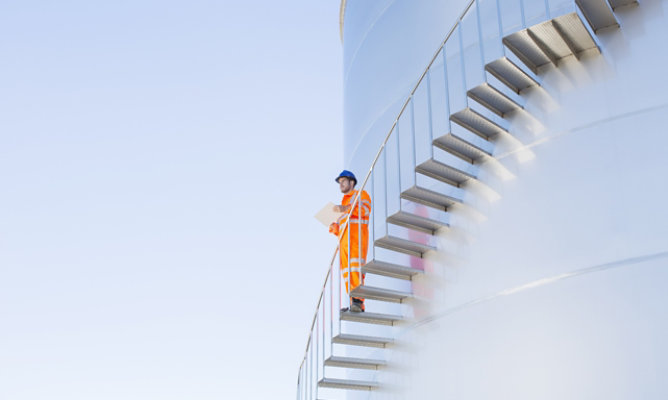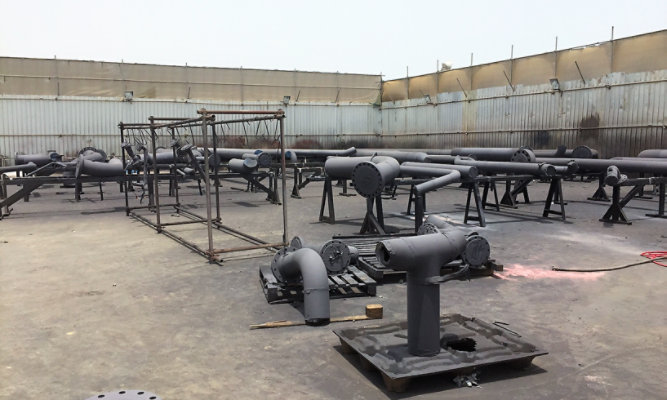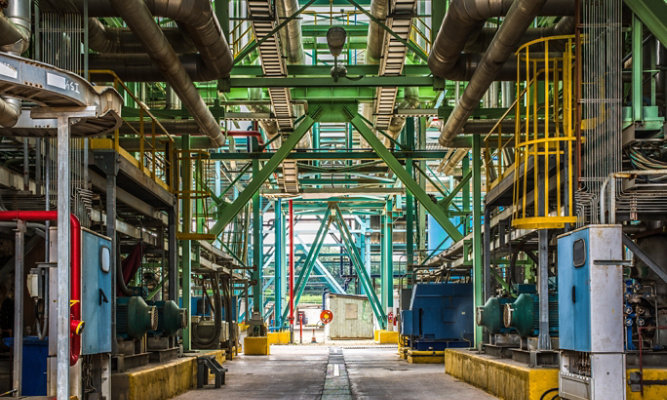Finding a Better Lining for Free Water Knockout Vessels
Flake-Reinforced Novolac Coating Extends FWKOs’ Lining Lives
By Ted Moore, Oil & Gas Project Development Manager, Sherwin-Williams Protective & Marine (Retired) and Travis Crotwell, Business Development Manager – Upstream Oil & Gas, Sherwin-Williams Protective & Marine

Inside free water knockout vessels (FWKOs) used in the upstream oil and gas market, high pressures and temperatures separate oil, gas and water from fluids extracted from the earth. These stresses present challenges to the coatings used to line such vessels. The coatings may crack and peel under the burdens of elevated pressure and heat. Add to that corrosive attacks from some of the most aggressive materials to come out of the ground, and it might seem like no coating can stand a chance at remaining adhered inside a FWKO over the long term.
That may be what a major multinational oil company originally thought when it ran into troubles with the linings used to protect the interiors of multiple FWKOs in use at its upstream production facilities. The novolac-based tank linings were failing prematurely – with significant cracking, blistering and peeling evident during regular cleanings. The deterioration was discovered in as little as six months during cleaning operations, and it likely started shortly after placing the vessels in service. That means parts of the vessels’ steel substrates may have been directly exposed to corrosive contents for nearly the entire time they were in operation. And that doesn’t bode well for the vessels’ service lives.
Looking to find a better solution that wouldn’t require premature vessel lining repairs or rehabilitations, the oil producer worked with Sherwin-Williams Protective & Marine to test a newer novolac-based tank lining material – Nova-Plate® 360 – in the field. The parties lined three FWKOs with the coating (Figure 1), which features the addition of flake reinforcements compared to the original coatings. The first vessel inspected after 18 months in continuous service showed no signs of lining failure, showing promise that this flake-reinforced material will perform significantly better and longer than the previously used non-reinforced linings.
Lining Troubles
Linings inside FWKOs are subject to some of the most aggressive conditions in the upstream market. Exposure to hot extracted fluids, continuous operation at temperatures of 120°F (50°C) – with spikes up to 180°F (82.2°C) – and periodic steam injections all require lining materials to have high temperature ratings so they don’t soften and lose physical properties. With vessels operating at a continuous pressure of about 250 psi, the linings also need to adhere incredibly well to the steel substrate to avoid peeling away. Finally, the array of impurities found in crude oil – from sulfur, nitrogen and mineral salts to unknown chemicals – can weaken linings, adding to their potential for disbonding from the vessel walls.
Under those three factors – elevated temperatures, high pressures and contact with highly corrosive fluids – the novolac-based tank linings originally used in the oil company’s FWKOs were failing early. Despite the coatings having a tight crosslinked matrix that would be expected to handle these stresses, the linings just weren’t performing. Any spot where they had cracked, blistered or peeled represented an area where pitting corrosion could take hold, potentially thinning the pressurized vessels’ walls and presenting risks to their long-term integrity.
Flake Reinforcements Add Protection
Because novolac linings create a tight crosslinked coating matrix, it is harder for molecules of moisture to penetrate the coating and work their way down to the steel substrate where they can initiate corrosion. This tight matrix is critical to enabling high temperature and chemical resistance in coatings, as the physical properties of the coatings should remain highly intact up to the materials’ rated parameters. However, if process heat or aggressive chemical exposures are too much for a coating, its crosslinked matrix may weaken and open up, allowing that moisture penetration and the subsequent coating deterioration that’s likely to follow. This is potentially what was happening with the original coatings applied to the oil company’s FWKOs.
Figure 1. To test the performance of Nova-Plate® 360, three FWKOs were lined with the flake-reinforced coating.
Sherwin-Williams suspected that a little added reinforcement in the coating matrix might help to overcome the property losses that were occurring with the original coatings. The company suggested a trial with the flake-reinforced Nova-Plate 360 lining material. Its novolac base provided the tight crosslink the linings required, with flakes of mica providing necessary added protection.
As the coating cures, the mica flakes lay on top of each other in a random, horizontal pattern that forms a platelike structure within the lining. These “plates” then create a torturous path for moisture to penetrate and flow through the coating matrix. For example, if one molecule of water works its way into the coating, it will encounter and have to bypass plate after plate of mica flakes before it can contact the underlying steel. Most moisture molecules won’t make it all the way through that path to the substate. These lamellar pigment flakes also help to improve the coating’s abrasion resistance.
Easier Applications
The three FWKO vessels coated with Nova-Plate 360 are each 45 feet long and 10 feet in diameter, with total interior surface areas of about 1600 square feet. The vessels are each about 20 years old and had been relined multiple times before the Nova-Plate 360 applications. Their steel was still in good shape with only some minor pitting noticeable.
To reline the vessels, applicators first removed all previous coatings and any contamination from the FWKO vessel interiors using the SSPC-SP 10 near-white metal blast cleaning method. Next, they spray-applied a stripe coat of Nova-Plate 360 on all welds and sharp edges inside the vessels before brushing and rolling those areas to work the coatings into any voids. Finally, they applied the lining on the entire interior of the vessels, spraying it to a thickness of 25- to 35-mils dry film thickness (DFT) over top of the wet stripe coat. The thick coat and flowability of the coating helped to fill in any light or moderate pitting on the steel to provide a smooth surface. This capability enabled applicators to skip the application of an epoxy surfacing compound. The coating’s high film build also meant the coating crew only had to apply one coat.
Applying Nova-Plate 360 was a faster and easier process when compared to using the previous coating systems. The main difference was that the older coatings required the use of plural-component airless application equipment, while Nova-Plate 360 can also be applied using single-leg airless equipment. The use of single-leg equipment for the three FWKOs meant applicators didn’t have to haul heavy plural-component equipment to the job site and wrestle with the logistics of working in a small, confined space with bulky equipment. The long pot life of Nova-Plate 360 also helped here, as applicators didn’t have to worry about the material hardening too quickly during applications.
Further helping with project efficiencies, Nova-Plate 360 can be returned to service within 48 hours after application, and sometimes before if ambient temperatures are higher. That enables operators to rehabilitate a FWKO lining and put the vessel back in operation quickly, following draining, cleaning, inspection, surface preparation and the lining application.
Inspections Show Promising Results
Inspection intervals for FWKOs are typically either five or 10 years. However, because the vessels are cleaned more frequently, operators often have the chance to perform intermediate visual inspections. That’s how the oil company discovered its original linings were failing so quickly. Due to the known issue of premature failures, the company opted to fully inspect the vessels lined with Nova-Plate 360 at just 18 months.

Figure 2. A thorough inspection of one FWKO lined with Nova-Plate 360 after 18 months of near continuous operation revealed a fully intact lining with no signs of cracking, blistering, peeling or even discoloration.

Figure 3. Visual inspections showed no signs of cracking or peeling, with just minimal mechanical damage present.
Visual inspections during intermediate cleanings before the scheduled inspection interval revealed no issues with the lining. The more complete 18-month inspection conducted by Bay Area Coating Consultants Inc. demonstrated the same (Figure 2). Inspectors looked for any visual signs of cracking or peeling but found none (Figure 3). They also paid careful attention to any signs of blistering, going to the extent of probing any areas where the coatings appeared to be raised up. In these areas, they used a knife to poke the raised coatings, discovering in each case that the additional profile was due to a run or drip of extra coating material that occurred during application. Inspectors weren’t able to peel the coatings away from the substrate in these areas, proving they weren’t blisters and confirming the tight adherence of the lining to the vessel substrate. In addition, the linings had maintained their original color and gloss with just light surface staining present (Figure 4), indicating excellent performance. Inspectors also confirmed the film thickness measurements were within specifications.
Even areas around the vessels’ manways and nozzles (Figure 5) were in good condition, showing no degradation, discoloration or evidence of reduced adhesion. These areas are prone to increased impacts and abrasions compared to other areas within the vessels. They also have sharp edges, which tend to receive lower coating film builds. However, the edge retentive nature of Nova-Plate 360 helped those areas retain a high film build that showed no signs of deterioration.
Only one of the oil company’s three FWKO vessels can be down at a time, meaning it would take a couple of weeks to inspect all three tanks. However, because the first vessel looked so good after 18 months, the operator decided not to take the other tanks out of service sooner than their normal inspection interval of five years. Personnel will still do visual inspections during intermediate cleanings, but if no failures are present, the company will be able to wait on the more comprehensive inspections.
Easier Tank Cleanings
The Nova-Plate 360 lining presented an additional benefit to the oil company when cleaning its FWKOs. It contains a polytetrafluoroethylene (PTFE) additive that creates a nonstick surface on the vessels’ walls. Sludgy residues from the FWKO separation process therefore release easily during cleanings, streamlining the process and reducing labor costs. As a result, the oil company is able to minimize downtime when taking a FWKO offline for maintenance and inspections. It may also be able to reduce its use of industrial detergents, which are sometimes needed to clean sticky deposits from vessel surfaces.
Nova-Plate 360 is also compatible with high-temperature steam cleanings, which subject areas of the lining to the thermal shock of steam hitting the otherwise ambient-temperature steel. This shock can cause incompatible coatings to disbond from substrates. Steam cleaning is usually performed with a wand that subjects concentrated areas to brief high-temperature exposures, but Nova-Plate 360 is also compatible with broad, longer-term exposures. For example, the oil company has tested the coating under steam out conditions, which subject entire vessel interiors to prolonged contact with hot steam. Cycling temperatures from 365°F steam to ambient temperature over five weeks revealed no loss of physical properties in the lining, as well as no discoloration.
A Better Lining
Based on the positive 18-month inspection of the FWKO vessel featuring the Nova-Plate 360 lining, the oil company anticipates superior performance from this lining compared to the ones it had originally used. The flake-reinforced novolac has demonstrated the resistance to heat, pressure, chemicals, abrasion and corrosion that are necessary to help it remain tightly adhered to the vessels’ substrates to protect their steel. The lining has also retained its original gloss and color, which is a strong indication that the process conditions are having no deleterious influence on it. Further inspections will determine if the lining continues to hold up to some of the most aggressive environments that coatings face.
ABOUT THE AUTHORS
Ted Moore was formerly an Oil & Gas Business Development Manager for Sherwin-Williams Protective & Marine.
Travis Crotwell is a Business Development Manager – Upstream Oil & Gas for Sherwin-Williams Protective & Marine. Crotwell’s responsibilities include serving as a corrosion specialist and providing engineering support for owners, operators and EPC firms. Additionally, he is responsible for market opportunity and market development across the upstream oil and gas market segment. Crotwell has 16 years of industry experience, including 15 years with The Sherwin-Williams Company, previously serving as a Field Technical Service Representative, NACE Coatings Inspector, Protective Coatings Specialist and Project Development Manager. Crotwell is a NACE CIP Certified Coating Inspector, SSPC CCI Certified Coatings Technician and a board member for the SSPC Gulf Coast Chapter. Contact: Travis.M.Crotwell@sherwin.com.
Figure 4. The linings showed excellent performance by maintaining their original color and gloss with just light surface staining present.
Figure 5. The lining material remained in good condition even in the FWKO vessel’s nozzles due to the coating’s high edge retention properties.
Discover More
Industry Expertise and Innovation
See how we help customers find customized solutions for their project and application challenges.
Our Oil & Gas Expertise
Explore our industry solutions and technology to help protect your assets.
LEARN MOREProduct Lookup
Find out more about our innovative coatings for a variety of industries.
FIND A PRODUCT

